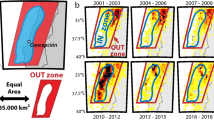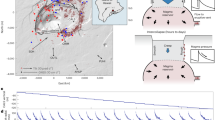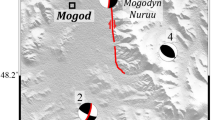Abstract
Constraints on the recurrence times of subduction zone earthquakes are important for seismic hazard assessment and mitigation. Models of such megathrust earthquakes often assume that subduction zones are segmented and earthquakes occur quasi-periodically owing to constant tectonic loading. Here we analyse the occurrence of small earthquakes compared to larger ones—the b-values—on a 1,000-km-long section of the subducting Pacific Plate beneath central and northern Japan since 1998. We find that the b-values vary spatially and mirror the tectonic regime. For example, high b-values, indicative of low stress, occur in locations characterized by deep magma chambers and low b-values, or high stress, occur where the subducting and overriding plates are strongly coupled. There is no significant variation in the low b-values to suggest the plate interface is segmented in a way that might limit potential ruptures. Parts of the plate interface that ruptured during the 2011 Tohoku-oki earthquake were highly stressed in the years leading up to the earthquake. Although the stress was largely released during the 2011 rupture, we find that the stress levels quickly recovered to pre-quake levels within just a few years. We conclude that large earthquakes may not have a characteristic location, size or recurrence interval, and might therefore occur more randomly distributed in time.
This is a preview of subscription content, access via your institution
Access options
Subscribe to this journal
Receive 12 print issues and online access
$259.00 per year
only $21.58 per issue
Buy this article
- Purchase on Springer Link
- Instant access to full article PDF
Prices may be subject to local taxes which are calculated during checkout





Similar content being viewed by others
References
Reid, H. F. The Mechanics of The Earthquake. The California Earthquake of April 18, 1906 Vol. 2 (Carnegie Institute, 1910).
Gutenberg, B. & Richter, C. F. Frequency of earthquakes in California. Bull. Seismol. Soc. Am. 34, 185–188 (1944).
Scholz, C. H. The frequency-magnitude relation of microfracturing in rock and its relation to earthquakes. Bull. Seismol. Soc. Am. 58, 399–415 (1968).
Goebel, T. H. W., Schorlemmer, D., Becker, T. W., Dresen, G. & Sammis, C. G. Acoustic emissions document stress changes over many seismic cycles in stick-slip experiments. Geophys. Res. Lett. 40, 1–6 (2013).
Kun, F., Varga, I., Lennartz-Sassinek, S. & Main, I. G. Approach to failure in porous granular materials under compression. Phys. Rev. E 88, 062207 (2013).
Wiemer, S. & Wyss, M. Mapping spatial variability of the frequency–magnitude distribution of earthquakes. Adv. Geophys. 45, 259–302 (2002).
Tormann, T., Wiemer, S. & Mignan, A. Systematic survey of high-resolution b value imaging along Californian faults: Inference on asperities. J. Geophys. Res. 119, 1–26 (2014).
Schorlemmer, D., Wiemer, S. & Wyss, M. Variations in earthquake-size distribution across different stress regimes. Nature 437, 539–542 (2005).
Schorlemmer, D. & Wiemer, S. Microseismicity data forecast rupture area. Nature 434, 1086 (2005).
Nanjo, K. Z., Hirata, N., Obara, K. & Kasahara, K. Decade-scale decrease in b value prior to the M9-class 2011 Tohoku and 2004 Sumatra quakes. Geophys. Res. Lett. 39, L20304 (2012).
Bachmann, C. E., Wiemer, S., Goertz-Allmann, B. P. & Woessner, J. Influence of pore-pressure on the event-size distribution of induced earthquakes. Geophys. Res. Lett. 39, L09302 (2012).
Wyss, M., Hasegawa, A. & Nakajima, J. Source and path of magma for volcanoes in the subduction zone of northeastern Japan. Geophys. Res. Lett. 28, 1819–1822 (2001).
Van Stiphout, T., Kissling, E., Wiemer, S. & Ruppert, N. Magmatic processes in the Alaska subduction zone by combined 3-D b value imaging and targeted seismic tomography. J. Geophys. Res. 114, B11302 (2009).
Hashimoto, C., Noda, A., Sagiya, T. & Matsu’ura, M. Interplate seismogenic zones along the Kuril–Japan trench inferred from GPS data inversion. Nature Geosci. 2, 141–144 (2009).
Uchida, N. & Matsuzawa, T. Coupling coefficient, hierarchical structure, and earthquake cycle for the source area of the 2011 off the Pacific coast of Tohoku earthquake inferred from small repeating earthquake data. Earth Planets Space 63, 675–679 (2011).
Ikeda, Y. Proc. Int. Symp. Eng. Lessons Learn. from 2011 Gt. East Japan Earthquake, March 1–4 2012, Tokyo, Japan 238–253 (Japan Association for Earthquake Engineering, 2012).
Toda, S. & Enescu, B. Rate/state Coulomb stress transfer model for the CSEP Japan seismicity forecast. Earth Planets Space 63, 171–185 (2011).
Nakaya, S. Spatiotemporal variation in b value within the subducting slab prior to the 2003 Tokachi-oki earthquake (M8.0), Japan. J. Geophys. Res. 111, B03311 (2006).
Kanda, R. V. S., Hetland, E. A. & Simons, M. An asperity model for fault creep and interseismic deformation in northeastern Japan. Geophys. J. Int. 192, 38–57 (2013).
Nishimura, T. Pre-, co-, and post-seismic deformation of the 2011 Tohoku-oki earthquake and its implication to a paradox in short-term and long-term deformation. J. Disaster Res. 9, 294–302 (2014).
Hardebeck, J. L. Coseismic and postseismic stress rotations due to great subduction zone earthquakes. Geophys. Res. Lett. 39, L21313 (2012).
Yagi, Y. & Fukahata, Y. Rupture process of the 2011 Tohoku-oki earthquake and absolute elastic strain release. Geophys. Res. Lett. 38, L19307 (2011).
Wei, S., Graves, R., Helmberger, D., Avouac, J-P. & Jiang, J. Sources of shaking and flooding during the Tohoku-Oki earthquake: A mixture of rupture styles. Earth Planet. Sci. Lett. 333–334, 91–100 (2012).
Pollitz, F. F., Bürgmann, R. & Banerjee, P. Geodetic slip model of the 2011 M9.0 Tohoku earthquake. Geophys. Res. Lett. 38, L00G08 (2011).
Suzuki, W., Aoi, S., Sekiguchi, H. & Kunugi, T. Rupture process of the 2011 Tohoku-Oki mega-thrust earthquake (M9.0) inverted from strong-motion data. Geophys. Res. Lett. 38, L00G16 (2011).
Hayes, G. P. Rapid source characterization of the 2011 Mw9.0 off the Pacific coast of Tohoku Earthquake. Earth Planets Space 63, 529–534 (2011).
Ghosh, A., Newman, A. V., Thomas, A. M. & Farmer, G. T. Interface locking along the subduction megathrust from b-value mapping near Nicoya Peninsula, Costa Rica. Geophys. Res. Lett. 35, L01301 (2008).
Asano, Y. et al. Spatial distribution and focal mechanisms of aftershocks of the 2011 off the Pacific coast of Tohoku Earthquake. Earth Planets Space 63, 669–673 (2011).
Toda, S., Lin, J. & Stein, R. S. Using the 2011 Mw 9.0 off the Pacific coast of Tohoku Earthquake to test the Coulomb stress triggering hypothesis and to calculate faults. Earth Planets Space 63, 725–730 (2011).
Stein, R. S. & Toda, S. Megacity megaquakes-two near misses. Science 341, 850–852 (2013).
Mogi, K. Magnitude-frequency relation for elastic shocks accompanying fractures of various materials and some related problems in earthquakes. Bull. Earthq. Res. Inst. 40, 831–853 (1962).
Sammonds, P. R., Meredith, P. G. & Main, I. G. Role of pore fluids in the generation of seismic precursors to shear fracture. Nature 359, 228–230 (1992).
Dieterich, J. H. A constitutive law for rate of earthquake its application to earthquake clustering. J. Geophys. Res. 99, 2601–2618 (1994).
Kagan, Y. Y. & Jackson, D. D. Seismic gap hypothesis: Ten years after. J. Geophys. Res. 96, 21419–21431 (1991).
Bak, P. & Tang, C. Earthquakes as a self-organized critical phenomenon. J. Geophys. Res. 94, 15635–15637 (1989).
Stein, S., Geller, R. J. & Liu, M. Why earthquake hazard maps often fail and what to do about it. Tectonophysics 562–563, 1–25 (2012).
National Seismic Hazard Maps for Japan (Headquarters for Earthquake Research Promotion, 2005); http://www.jishin.go.jp/main/index-e.html
Geller, R. J. Shake-up time for Japanese seismology. Nature 472, 407–409 (2011).
Kagan, Y. Y., Jackson, D. D. & Geller, R. J. Characteristic earthquake model, 1884–2011, R.I.P. Seismol. Res. Lett. 83, 951–953 (2012).
Kagan, Y. Y. & Jackson, D. D. Tohoku earthquake: A surprise? Bull. Seismol. Soc. Am. 103, 1181–1194 (2013).
Kulkarni, R., Wong, I., Zachariasen, J., Goldfinger, C. & Lawrence, M. Statistical analyses of great earthquake recurrence along the Cascadia Subduction Zone. Bull. Seismol. Soc. Am. 103, 3205–3221 (2013).
Rosenau, M. & Oncken, O. Fore-arc deformation controls frequency-size distribution of megathrust earthquakes in subduction zones. J. Geophys. Res. 114, B10311 (2009).
Hayes, G. P., Wald, D. J. & Johnson, R. L. Slab1.0: A three-dimensional model of global subduction zone geometries. J. Geophys. Res. 117, B01302 (2012).
Woessner, J. & Wiemer, S. Assessing the quality of earthquake catalogues: Estimating the magnitude of completeness and its uncertainty. Bull. Seismol. Soc. Am. 95, 684–698 (2005).
Nanjo, K. Z. et al. Analysis of the completeness magnitude and seismic network coverage of Japan. Bull. Seismol. Soc. Am. 100, 3261–3268 (2010).
Tormann, T. & Wiemer, S. Reply to “comment on ‘changes of reporting rates in the Southern California earthquake catalog, introduced by a new definition of ML’ by Thessa Tormann, Stefan Wiemer, and Egill Hauksson” by Duncan Carr Agnew. Bull. Seismol. Soc. Am. 100, 3325–3328 (2010).
Aki, K. Maximum likelihood estimate of b in the formula logN = a − bM and its confidence limits. Bull. Earthq. Res. Inst. 43, 237–239 (1965).
Shi, Y. & Bolt, B. A. The standard error of the magnitude-frequency b value. Bull. Seismol. Soc. Am. 72, 1677–1687 (1982).
Yagi, Y. Source rupture process of the 2003 Tokachi-oki earthquake determined by joint inversion of teleseismic body wave and strong ground motion data. Earth Planets Space 56, 311–316 (2004).
Tormann, T., Wiemer, S., Metzger, S., Michael, A. J. & Hardebeck, J. L. Size distribution of Parkfield’s microearthquakes reflects changes in surface creep rate. Geophys. J. Int. 193, 1474–1478 (2013).
Acknowledgements
We thank J. Hardebeck, S. Jónsson and M. Wyss for feedback on the manuscript. We thank JMA for sharing the earthquake catalogue. Figures were produced with The Generic Mapping Tools http://gmt.soest.hawaii.edu. Part of this study was funded through SNF grant PMPDP2 134174. B.E. acknowledges support from the ‘Mega-Earthquake Risk Management’ project at the University of Tsukuba.
Author information
Authors and Affiliations
Contributions
B.E. obtained, selected and pre-processed the earthquake data sets used in this study and provided expert opinion on the Japanese seismotectonics. T.T. led the design of, implemented and conducted the data analysis, and was responsible for result visualization. S.W. and J.W. contributed to the design of the analysis. J.W. contributed to figure generation. All authors participated in the discussion and interpretation of results and the writing of the manuscript.
Corresponding author
Ethics declarations
Competing interests
The authors declare no competing financial interests.
Supplementary information
Supplementary Information
Supplementary Information (PDF 1339 kb)
Rights and permissions
About this article
Cite this article
Tormann, T., Enescu, B., Woessner, J. et al. Randomness of megathrust earthquakes implied by rapid stress recovery after the Japan earthquake. Nature Geosci 8, 152–158 (2015). https://doi.org/10.1038/ngeo2343
Received:
Accepted:
Published:
Issue Date:
DOI: https://doi.org/10.1038/ngeo2343
This article is cited by
-
b map evaluation and on-fault stress state for the Antakya 2023 earthquakes
Scientific Reports (2024)
-
A review on slow earthquakes in the Japan Trench
Progress in Earth and Planetary Science (2023)
-
Activated volcanism of Mount Fuji by the 2011 Japanese large earthquakes
Scientific Reports (2023)
-
Seismic Hazards Along the Longmen Shan Fault: Insights from Stress Transfer Between Major Earthquakes and Regional b-Values
Pure and Applied Geophysics (2023)
-
Revealing the spatiotemporal complexity of the magnitude distribution and b-value during an earthquake sequence
Nature Communications (2022)



